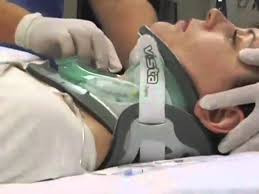Definisi
Siringomielia adalah penyakit saraf langka berupa terbentuknya kista berisi cairan pada sumsum tulang belakang. Cairan tersebut adalah cairan serebrospinal (CSF), yaitu cairan yang mengelilingi dan melindungi otak serta sumsum tulang belakang. Ketika aliran cairan serebrospinal tersumbat, kelebihan cairan dapat masuk ke dalam sumsum tulang belakang. Inilah awal dari terbentuknya kista tersebut.
Seiring waktu, kista dapat membesar dan merusak sumsum tulang belakang, meskipun beberapa kista dapat stabil bahkan menghilang. Jika sampai merusak sumsum tulang belakang, akan menimbulkan rasa sakit, kelemahan, dan kekakuan.
Siringomielia memiliki beberapa kemungkinan penyebab, meskipun sebagian besar kasus terkait dengan kondisi penonjolan jaringan otak ke kanal tulang belakang (malformasi Chiari). Penyebab lain dari siringomielia adalah tumor sumsum tulang belakang, cedera tulang belakang, atau peradangan di sekitar sumsum tulang belakang.
Jika siringomielia tidak menimbulkan keluhan, penanganan cukup dengan memantau kondisi pasien. Namun, jika terdapat keluhan yang mengganggu, operasi mungkin diperlukan.
Penyebab
Siringomielia terbentuk ketika cairan serebrospinal berkumpul membentuk kista di dalam sumsum tulang belakang. Terdapat beberapa kondisi dan penyakit yang dapat menyebabkan siringomielia, yaitu:
- Malformasi Chiari, yaitu jaringan otak menonjol ke dalam kanal tulang belakang. Kondisi ini merupakan kelainan kongenital, yaitu kelainan yang terbentuk sejak dalam kandungan
- Meningitis, yaitu peradangan pada selaput yang mengelilingi otak dan sumsum tulang belakang
- Tumor sumsum tulang belakang. Kondisi ini dapat mengganggu sirkulasi normal cairan serebrospinal
- Kondisi saat lahir, seperti ketika ada jaringan yang menempel pada sumsum tulang belakang sehingga membatasi gerakannya
- Cedera sumsum tulang belakang, gejalanya dapat timbul setelah berbulan-bulan atau bertahun-tahun kemudian
Faktor Risiko
Faktor risiko utama siringomielia berkaitan dengan penyebab yang mendasarinya. Beberapa kondisi berikut berperan sebagai faktor risiko siringomielia:
- Faktor risiko iatrogenik, yaitu risiko yang timbul akibat tindakan medis. Misalnya, perdarahan yang banyak pada lokasi pembedahan atau lokasi cedera akibat benda tajam dikaitkan dengan peningkatan risiko terbentuk fibrosis (jaringan parut) yang dapat menghambat sirkulasi cairan serebrospinal
- Faktor risiko lainnya yaitu stenosis (penyempitan) kanal tulang belakang (>25%) dan kifosis (tulang belakang bengkok ke depan) pasca cedera (>15%)
- Malformasi (pembentukan yang gagal) kongenital, seperti malformasi Chiari, sindrom Klippel Feil, atau skoliosis kongenital (tulang belakang terlalu melengkung ke samping sejak lahir)
- Pasca infeksi: pembentukan arakhnoiditis (peradangan lapisan arakhnoid yang membungkus otak) dan pembentukan abses dura (penumpukan nanah pada lapisan otak terluar)
- Pasca cedera: cedera tulang belakang merupakan faktor risiko yang paling berperan
- Pasca peradangan: sklerosis multipel, neurosarkoidosis, amyotrophic lateral sclerosis (ALS)
- Neoplasma atau tumor: Ependimoma dan hemangioblastoma adalah tumor yang sering berkaitan dengan terbentuknya siringomielia
Gejala
Gejala siringomielia biasanya berkembang perlahan seiring waktu. Gejala timbul ketika kista berisi cairan menekan saraf sumsum tulang belakang. Gejala yang ada menunjukkan letak kista dan seberapa besar tekanan pada saraf yang disebabkan oleh pembesaran kista. Jika siringomielia disebabkan oleh penonjolan jaringan otak ke dalam kanal tulang belakang (malformasi Chiari), gejala umumnya dimulai antara usia 25 dan 40 tahun.
Pada beberapa kasus, batuk atau mengejan dapat memicu gejala siringomielia, meskipun tidak menyebabkan siringomielia. Tanda dan gejala siringomielia dapat mempengaruhi punggung, bahu, lengan, atau kaki. Tanda dan gejala tersebut meliputi:
- Kelemahan dan penyusutan otot (atrofi)
- Kehilangan refleks
- Kehilangan kepekaan terhadap rasa sakit dan suhu
- Sakit kepala
- Kekakuan pada punggung, bahu, lengan, dan kaki
- Sakit di leher, lengan, dan punggung
- Kelengkungan tulang belakang yang tidak normal (skoliosis)
- Gangguan pencernaan dan saluran kemih seperti inkotinensia (tidak bisa menahan buang air)
Diagnosis
Dalam mendiagnosis, dokter akan menanyakan gejala, riwayat kesehatan, dan melakukan pemeriksaan fisik lengkap. Pada beberapa kasus, siringomielia ditemukan secara tidak sengaja saat pemeriksaan MRI atau CT scan tulang belakang karena alasan lain.
Jika dokter Anda mencurigai siringomielia, beberapa pemeriksaan penunjang berikut dapat direkomendasikan untuk Anda:
- MRI. MRI tulang belakang dan sumsum tulang belakang adalah pemeriksaan yang paling baik untuk mendiagnosis siringomielia. Pemeriksaan ini menggunakan gelombang radio dan medan magnet yang kuat untuk menghasilkan gambar detail tulang belakang dan sumsum tulang belakang. Jika kista telah berkembang di dalam sumsum tulang belakang, kista akan terlihat pada pemeriksaan MRI. Pada beberapa kasus, dokter akan menyuntikkan pewarna ke dalam pembuluh darah untuk menemukan kemungkinan tumor atau kelainan lainnya. Dokter dapat melakukan beberapa kali MRI untuk memonitor perkembangan siringomielia.
- CT scan. Pemeriksaan ini menggunakan serangkaian sinar-X untuk menghasilkan gambaran tulang belakang dan sumsum tulang belakang secara detail. Pemeriksaan ini juga dapat mendeteksi tumor atau kondisi tulang belakang lainnya.
Tata Laksana
Pengobatan siringomielia tergantung pada tingkat keparahan dan perkembangan tanda serta gejalanya.
Pemantauan
Jika siringomielia tidak menimbulkan tanda atau gejala, pemantauan cukup dilakukan melalui pemeriksaan saraf dan MRI secara berkala.
Pembedahan
Jika siringomielia menimbulkan tanda dan gejala yang mengganggu, atau jika tanda dan gejala memburuk dengan cepat, dokter dapat merekomendasikan tindakan operasi. Tujuan operasi adalah untuk menghilangkan tekanan pada sumsum tulang belakang yang disebabkan oleh kista. Operasi juga akan mengembalikan aliran normal cairan serebrospinal. Tindakan ini dapat membantu memperbaiki gejala dan fungsi sistem saraf. Jenis operasi yang diperlukan tergantung pada penyebab siringomielia.
Untuk mengurangi tekanan pada otak dan sumsum tulang belakang, pilihan operasi meliputi:
- Mengobati malformasi Chiari. Jika siringomielia disebabkan oleh malformasi Chiari, pembedahan meliputi tindakan pengangkatan sejumlah kecil tulang di tengkorak bagian belakang. Operasi ini dapat mengurangi tekanan pada otak dan sumsum tulang belakang, mengembalikan aliran cairan serebrospinal menjadi normal, dan memperbaiki atau mengatasi gejala siringomielia.
- Mengeluarkan cairan di dalam kista. Dokter Anda akan memasang saluran drainase ke dalam kista melalui pembedahan. Saluran ini disebut shunt. Sebuah pipa lentur akan mengalirkan cairan dari dalam kista ke arah yang diinginkan. Salah satu ujung pipa ditempatkan di dalam kista, dan ujung lainnya ditempatkan di area lain tubuh seperti perut.
- Menyingkirkan sumbatan. Jika terdapat sesuatu di dalam sumsum tulang belakang, seperti tumor atau pertumbuhan tulang tidak normal, akan menghambat aliran cairan serebrospinal. Pembedahan bertujuan untuk menghilangkan sumbatan tersebut, melancarkan aliran cairan serebrospinal, dan memungkinkan cairan mengalir keluar dari dalam kista.
- Memperbaiki kelainan. Jika terdapat kelainan pada tulang belakang yang menghalangi aliran cairan serebrospinal, pembedahan untuk mengatasi kelainan tersebut akan memperlancar aliran cairan serebrospinal dan memungkinkan pengeluaran cairan dari dalam kista.
Pembedahan tidak selalu bisa mengembalikan aliran cairan serebrospinal. Kista juga mungkin akan tetap ada. Namun, adanya upaya untuk mengalirkan cairan dari dalam kista dapat menunda perburukan.
Follow up
Siringomielia dapat kambuh setelah operasi. Pasien perlu melakukan pemeriksaan rutin dengan dokter secara berkala untuk menilai hasil operasi. Kista dapat tumbuh kembali dan membutuhkan penanganan tambahan. Bahkan setelah perawatan, beberapa tanda dan gejala siringomielia bisa saja tetap ada karena kista dapat menyebabkan kerusakan permanen pada saraf dan sumsum tulang belakang.
Hidup dengan kondisi siringomielia dan komplikasinya dapat menjadi tantangan bagi pasien. Adanya seseorang yang bisa diajak bicara, seperti teman, konselor ,atau terapis, akan sangat berguna bagi pasien. Dukungan juga bisa diperoleh melalui kelompok pendukung sesama pasien siringomielia.
Bertanyalah pada dokter Anda mengenai rekomendasi kelompok pendukung di sekitar tempat tinggal Anda. Kelompok pendukung biasanya menyediakan forum untuk berbagi pengalaman, tips, dan menjadi sumber informasi yang baik.
Komplikasi
Pada beberapa orang, siringomielia dapat berkembang dan menyebabkan komplikasi yang serius. Pada kasus lainnya, kondisi ini dapat tidak bergejala. Komplikasi bisa terjadi saat kista membesar atau jika sudah sampai merusak saraf di dalam sumsum tulang belakang. Kemungkinan komplikasinya antara lain:
- Kelengkungan tulang belakang yang tidak normal (skoliosis)
- Nyeri kronis akibat kerusakan sumsum tulang belakang
- Gangguan gerak motorik, seperti kelemahan dan kekakuan pada otot kaki yang dapat mempengaruhi cara berjalan
- Kelumpuhan
Pencegahan
Belum diketahui pasti bagaimana cara efektif untuk mencegah siringomielia. Namun, langkah-langkah berikut dapat membantu mengurangi gejala dan perburukan pada siringomielia
- Hindari aktivitas yang dapat memperburuk gejala, seperti angkat berat, mengejan, atau memberi beban berlebih pada tulang belakang.
- Pertimbangkan terapi fisik jika siringomielia menyebabkan kondisi yang menurunkan mobilitas dan aktivitas Anda. Kondisi tersebut seperti kelemahan otot, nyeri, kelelahan, atau kekakuan. Terapis fisik dapat membuat program latihan untuk Anda agar membantu mengurangi gejala yang Anda rasakan. Anda dapat berkonsultasi dengan dokter mengenai rekomendasi ahli terapi fisik yang tepat.
- Kelola nyeri kronis. Jika Anda menderita nyeri kronis akibat siringomielia, konsultasi dengan dokter mengenai pilihan pengobatan. Terdapat banyak pusat kesehatan yang sudah memiliki dokter spesialis manajemen nyeri.
Kapan Harus ke Dokter?
Jika Anda memiliki salah satu tanda atau gejala siringomielia di atas, lakukan konsultasi dengan dokter Anda. Jika Anda pernah mengalami cedera tulang belakang, perhatikan kemungkinan timbul tanda dan gejala siringomielia. Tanda dan gejala tersebut dapat muncul setelah berbulan-bulan hingga bertahun-tahun setelah cedera. Konsultasikan juga dengan dokter mengenai kondisi cedera tulang belakang Anda.
Mau tahu informasi seputar penyakit lainnya? Cek di sini, ya!
- dr Nadia Opmalina
Syringomyelia. (2019). Retrieved 13 Desember 2021, from https://www.mayoclinic.org/diseases-conditions/siringomielia/diagnosis-treatment/drc-20354775
Al-Shatoury HAH. (2021). Retrieved 13 Desember 2021, from https://emedicine.medscape.com/article/1151685-overview#showall
Giner J, Lopez CP, dan Roda JM. (2019). Update on pathophysiology and management of syringomyelia unrelated to Chiari malformation. Neuralgia. 34(5):318-325.
Krause L. (2019). Syringomyelia. Retrieved 13 Desember 2021, from https://www.healthline.com/health/siringomielia
Syringomyelia. (2021). Retrieved 13 Desember 2021, from https://www.ninds.nih.gov/Disorders/Patient-Caregiver-Education/Fact-Sheets/siringomielia-Fact-Sheet
Syringomyelia. (2021). Retrieved 13 Desember 2021, from https://www.neurosurgery.columbia.edu/patient-care/conditions/siringomielia
Syringomyelia. (2020). Retrieved 13 Desember 2021, from https://rarediseases.org/rare-diseases/siringomielia/












